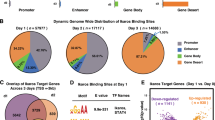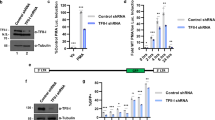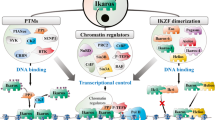Abstract
Interleukin 4 (IL-4) is a multifunctional cytokine that plays an important role in hematopoiesis, tumor cell growth, and cellular immune responses. Expression of the IL-4 gene is tightly controlled at the level of gene transcription, and many positive regulatory cis-elements have been identified in the proximal IL-4 promoter region. Relatively little is known about factors that downregulate IL-4 transcription. We performed a detailed deletional analysis of the proximal human IL-4 promoter and studied reporter gene activity in transiently transfected Jurkat T lymphoblasts. In this report, we characterize a novel negative regulatory element (termed P2 NRE) that is adjacent to a binding site for nuclear factor of activated T cells. Mutation of P2 NRE significantly enhanced the activity of a 175 base pair IL-4 promoter construct in transiently transfected Jurkat T lymphoblasts. Using nuclear extracts from Jurkat cells, we identify a candidate factor (termed Rep-1) that binds uniquely to the P2 NRE in DNA-binding assays. Rep-1 is not related to other factors previously shown to interact with the IL-4 promoter, and by UV cross-linking and SDS-PAGE analysis, we found that it migrates with a molecular mass of approximately 150 kDa. Characterizing the molecular mechanisms responsible for downregulating the IL-4 promoter should enhance our understanding of IL-4-gene dysregulation in disease states.
This is a preview of subscription content, access via your institution
Access options
Subscribe to this journal
Receive 12 print issues and online access
$259.00 per year
only $21.58 per issue
Buy this article
- Purchase on Springer Link
- Instant access to full article PDF
Prices may be subject to local taxes which are calculated during checkout







Similar content being viewed by others
References
Abbas A, Murphy K, Sher A . Functional diversity of helper T lymphocytes Nature 1996 383: 787–793
O'Garra A . Cytokines induce the development of functionally heterogeneous T helper cell subsets Immunity 1998 8: 275–283
Robinson DS, Hamid Q, Ying S et al. Predominant TH2-like bronchoalveolar T-lymphocyte population in atopic asthma New Engl J Med 1992 326: 298–304
Casolaro V, Georas S, Song Z, Ono S . Biology and genetics of atopic disease Curr Opin Immunol 1996 8: 796–803
Vellenga E, Dokter W, Halie RM . Interleukin-4 and its receptor; modulating effects on immature and mature hematopoietic cells Leukemia 1993 7: 1131–1141
Nilsson G, Nilsson K . Effects of interleukin (IL)-13 on immediate–early response gene expression, phenotype and differentiation of human mast cells. Comparison with IL-4 Eur J Immunol 1995 25: 870–873
Sillaber C, Strobl H et al. IL-4 regulates c-kit proto-oncogene product expression in human mast and myeloid progenitor cells J Immunol 1991 147: 4224–4228
Sallusto F, Lanzavecchia A . Efficient presentation of soluble antigen by cultured human dendritic cells is maintained by granulocyte/macrophage colony-stimulating factor plus interleukin 4 and downregulated by tumor necrosis factor alpha J Exp Med 1994 179: 1109–1118
Vella A, Teague TK, Ihle J, Kappler J, Marrack P . Interleukin 4 (IL-4) or IL-7 prevents the death of resting T cells: stat6 is probably not required for the effect of IL-4 J Exp Med 1997 186: 325–330
Dutcher JP, Venkatraj U, Makower D, Wiernik PH . Interleukin-4 is a pleotropic cytokine with effects on B-cell malignancies (comment) Leukemia Res 1997 21: 17–19
Obiri NI, Hillman GG, Haas GP, Sud S, Puri RK . Expression of high affinity interleukin-4 receptors on human renal cell carcinoma cells and inhibition of tumor cell growth in vitro by interleukin-4 J Clin Invest 1993 91: 88–93
Gooch JL, Lee AV, Yee D . Interleukin 4 inhibits growth and induces apoptosis in human breast cancer cells Cancer Res 1998 58: 4199–4205
Topp MS, Koenigsmann M, Mire-Sluis A et al. Recombinant human interleukin-4 inhibits growth of some human lung tumor cell lines in vitro and in vivo Blood 1993 82: 2837–2844
Topp MS, Papadimitriou CA, Eitelbach F et al. Recombinant human interleukin 4 has antiproliferative activity on human tumor cell lines derived from epithelial and nonepithelial histologies Cancer Res 1995 55: 2173–2176
Leach MW, Snyder EA, Sinha DP, Rosenblum IY . Safety evaluation of recombinant human interleukin-4. I. Preclinical studies Clin Immunol Immunopathol 1997 83: 8–11
Chuvpilo S, Schomberg C, Gerwig R et al. Multiple closely-linked NFAT/octamer and HMG I(Y) binding sites are part of the interleukin-4 promoter Nucleic Acids Res 1993 21: 5694–5704
Abe E, De Waal Malefyt R, Matsuda I, Arai K, Arai N . An 11 base-pair DNA sequence motif apparently unique to human interleukin 4 gene confers responsiveness to T-cell activation signals Proc Natl Acad Sci USA 1992 89: 2864–2870
Szabo S, Gold J, Murphy T, Murphy K . Identification of cis-acting regulatory elements controlling interleukin-4 gene expression in T cells: roles for NF-Y and NF-AT Mol Cell Biol 1993 13: 4793–4805
Li-Weber M, Eder A, Krafft-Czepa H, Krammer P . T cell-specific negative regulation of transcription of the human cytokine IL-4 J Immunol 1992 148: 1913–1918
Li-Weber M, Krafft H, Krammer P . A novel enhancer element in the human IL-4 promoter is suppressed by a position-independent silencer J Immunol 1993 151: 1371–1382
Li-Weber M, Davydov I, Krafft H, Krammer P . The role of NF-Y and IRF-2 in the regulation of human IL-4 gene expression J Immunol 1994 153: 4122–4133
Li-Weber M, Salgame P, Hu C, Davydov I, Krammer P . Differential interaction of nuclear factors with the PRE-I enhancer element of the human IL-4 promoter in different T cell subsets J Immunol 1997 158: 1194–1200
Rooney J, Hoey T, Glimcher L . Coordinate and cooperative roles for NF-AT and AP-1 in the regulation of the murine IL-4 gene Immunity 1995 2: 473–483
Todd M, Grusby M, Lederer J, Lacy E, Lichtman A, Glimcher L . Transcription of the interleukin 4 gene is regulated by multiple promoter elements J Exp Med 1993 177: 1663–1674
Tara D, Weiss D, Brown M . An activation-responsive element in the murine IL-4 gene is the site of an inducible DNA-protein interaction J Immunol 1993 151: 3617–3626
Bruhn K, Nelms K, Boulay J, Paul W, Lenardo M . Molecular dissection of the murine interleukin-4 promoter Proc Natl Acad Sci USA 1993 90: 9707–9711
Takemoto N, Koyano-Nakagawa N, Arai N, Arai K, Yokota T . Four P-like elements are required for optimal transcription of the mouse IL-4 gene: involvement of a distinct set of nuclear factor of activated T cells and activator protein-1 family proteins Int Immunol 1997 9: 1329–1338
Szabo SJ, Glimcher LH, Ho IC . Genes that regulate interleukin-4 expression in T cells Curr Opin Immunol 1997 9: 776–781
Henkel G, Brown M . PU. 1 and GATA: components of a mast cell-specific interleukin 4 itronic enhancer Proc Natl Acad Sci USA 1994 91: 7737–7741
Kubo M, Ransom J, Webb D, Hashimoto Y, Tada T, Nakayama T . T-cell subset-specific expression of the IL-4 gene is regulated by a silencer element and STAT6 EMBO J 1997 16: 4007–4020
Davydov I, Krammer P, Li-Weber M . Nuclear factor-IL-6 activates the human IL-4 promoter in T cells J Immunol 1995 155: 5273–5279
Otsuka T, Villaret D, Yokota T et al. Structural analysis of the mouse chromosomal gene encoding interleukin 4 which expresses B cell, T cell and mast cell stimulating activities Nucleic Acids Res 1987 15: 333–344
Casolaro V, Georas S, Song Z et al. Inhibition of NF-AT-dependent transcription by NF-κB: implications for differential cytokine gene expression Proc Natl Acad Sci USA 1995 92: 11623–11627
Schreiber E, Matthias P, Müller M, Schaffner W . Rapid detection of octamer binding proteins with mini-extracts from a small number of cells Nucleic Acids Res 1989 17: 6419
Li-Weber M, Salgame P, Hu C, Krammer PH . Characterization of constitutive and inducible transcription factors binding to the P2 NF-AT site in the human interleukin-4 promoter Gene 1997 188: 253–260
Ho IC, Hodge MR, Rooney JW, Glimcher LH . The proto-oncogene c-maf is responsible for tissue-specific expression of interleukin-4 Cell 1996 85: 973–983
Lederer J, Perez V, DesRoches L, Kim S, Abbas A, Lichtman A . Cytokine transcriptional events during helper T cell subset differentiation J Exp Med 1996 184: 397–406
Rincon M, Flavell R . Transcription mediated by NFAT is highly inducible in effector CD4+ T helper 2 (Th2) cells but not in Th1 cells Mol Cell Biol 1997 17: 1522–1534
Klein-Hessling S, Schneider G, Heinfling A, Chuvpillo S, Serfling E . HMGI(Y) interferes with DNA binding of NF-AT factors and the induction of the interleukin 4 promoter in T cells Proc Natl Acad Sci USA 1996 93: 15311–15316
Georas S, Cumberland J, Burke T, Chen R, Schindler U, Casolaro V . Stat6 inhibits interleukin 4 promoter activity in T cells Blood 1998 92: 4529–4538
Nabel G, Gorka C, Baltimore D . T-cell-specific expression of interleukin 2: evidence for a negative regulatory site Proc Natl Acad Sci USA 1988 85: 2934–2938
Yasui DH, Genetta T, Kadesch T et al. Transcriptional repression of the IL-2 gene in Th cells by ZEB J Immunol 1998 160: 4433–4440
Mathey-Prevot B, Andrews N, Murphy H, Kreissman S, Nathan D . Positive and negative elements regulate human interleukin 3 expression Proc Natl Acad Sci USA 1990 87: 5046–5050
Ye J, Cippitelli M, Dorman L, Ortaldo J, Young H . The nuclear factor YY1 supresses the human gamma interferon promoter through two mechansisms: inhibition of AP1 binding and activation of a silencer element Mol Cell Biol 1996 16: 4744–4753
Fong C-L, Siddiqui A, Mark D . Identification and characterization of a novel repressor site in the human tumor necrosis factor alpha gene Nucleic Acids Res 1994 22: 1108–1114
Kuhl D, de la Fuente J, Chaturvedi M et al. Reversible silencing of enhancers by sequences derived from the human IFN-alpha promoter Cell 1987 50: 1057–1069
Nourbakhsh M, Hoffmann K, Hauser H . Interferon-beta promoters contain a DNA element that acts as a position-independent silencer on the NF-kappaB site EMBO J 1993 12: 451–459
Mu X, Kay NE, Gosland MP, Jennings CD . Analysis of blood T-cell cytokine expression in B-chronic lymphocytic leukaemia: evidence for increased levels of cytoplasmic IL-4 in resting and activated CD8 T cells Br J Haematol 1997 96: 733–735
de Totero D, Reato G, Mauro F et al. IL4 production and increased CD30 expression by a unique CD8+ T-cell subset in B-cell chronic lymphocytic leukaemia Br J Haematol 1999 104: 589–599
Lee PP, Zeng D, McCaulay AE et al. T helper 2-dominant antilymphoma immune response is associated with fatal outcome Blood 1997 90: 1611–1617
Acknowledgements
We thank Dr Anjana Rao and Dr Gerald Crabtree for the generous gifts of reagents. Cindy Chang and Mary Brummet provided invaluable assistance with the UV cross-linking experiments. This work was supported by grants from the National Institutes of Health, the American Lung Association, and the Johns Hopkins University School of Medicine Clinician Scientist Program.
Author information
Authors and Affiliations
Rights and permissions
About this article
Cite this article
Georas, S., Cumberland, J., Burke, T. et al. Characterization of a novel negative regulatory element in the human interleukin 4 promoter. Leukemia 14, 629–635 (2000). https://doi.org/10.1038/sj.leu.2401712
Received:
Accepted:
Published:
Issue Date:
DOI: https://doi.org/10.1038/sj.leu.2401712



